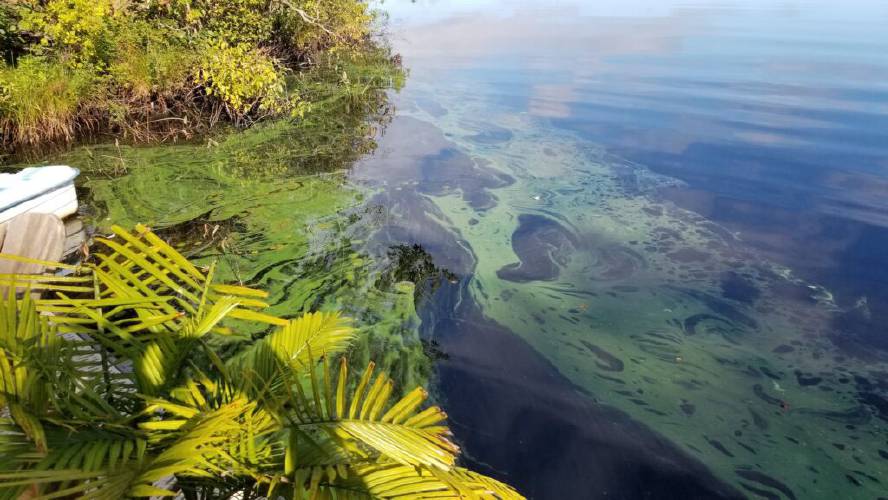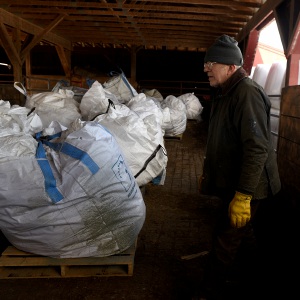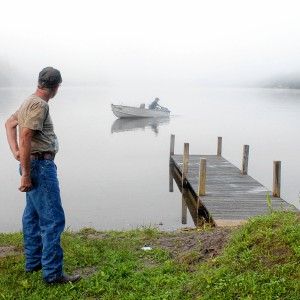With year-round cyanobacteria blooms, a northern NH lake community seeks a solution

Cyanobacteria occurs naturally, but when there are too many nutrients in the water the growth can get out of control. Here, a bloom on Phillips Pond in Sandown, N.H., in a photo taken in September 2021. (Courtesy of the New Hampshire Department of Environmental Services) Courtesy of the New Hampshire Department of Environmental Services
| Published: 03-23-2025 12:01 PM |
Even under the ice, cyanobacteria have been blooming in Partridge Lake.
The water body located in Littleton and Lyman has suffered from frequent bouts of the photosynthetic bacteria, which feed on sunlight and nutrients. Cyanobacteria can produce toxins, putting human health, wildlife, pets, and the state’s lake recreation at risk.
Now, property owners around the lake are seeking permission from the state to apply a treatment involving aluminum compounds to the lake in May or June, which is intended to help manage the blooms and improve water quality. Such treatments have been used elsewhere in the state with success.
“Long story short is that Partridge Lake is in trouble, and it’s been in trouble for quite a while,” said Laura Diemer, a certified lake manager and the consult lead on the project with FB Environmental Associates, at a public hearing. “And it’s likely that these blooms will keep getting worse without an intervention, like the alum treatment that we’re proposing, especially when you’re considering the compounding impact from climate change.”
Since the project involves releasing the compounds into the water, the state must approve a request for a surface water quality discharge permit for it to go forward. The Department of Environmental Services is accepting public comments on the permit application from the Partridge Lake Property Owners Association until 4 p.m. on Wednesday, March 26. It also held a public hearing earlier this month in Littleton, which was also available virtually.
Cyanobacteria have been a mounting issue for water bodies across the state, with warming global temperatures helping feed their rise. The blooms can produce toxins that can kill pets and cause a variety of health problems in humans: rashes, fevers, headaches, mouth blisters, vomiting, acute liver damage, and more, according to DES. Dozens of cyanobacteria warnings were issued last year.
For years, Diemer said, Partridge Lake has dealt with “recurrent and persistent” blooms — some across the whole lake and some appearing as surface scum along the shoreline. The town of Littleton, with the involvement of the property owners association and the help of a state loan, commissioned a watershed restoration plan for the lake, which was published in August 2022. It recommended the alum treatments to help combat the lake’s cyanobacteria problems.
The restoration plan estimates that 55% of the lake’s total phosphorus load comes from internal loading, where phosphorus is released into the water from the lake sediment. Low oxygen conditions, which are more common later in the summer, facilitate this release of phosphorus, Diemer said. Cyanobacteria then feed off that phosphorus in the water column.
Article continues after...
Yesterday's Most Read Articles
 After a year of looking, White River Junction couple finds new home
After a year of looking, White River Junction couple finds new home
 NH Republicans move forward with three different plans to expand EFAs
NH Republicans move forward with three different plans to expand EFAs
 Fires destroy two Upper Valley homes
Fires destroy two Upper Valley homes
This is significant because phosphorus is typically the most limiting nutrient for cyanobacteria growth, Diemer said, meaning its excess presence can help spur blooms. The alum treatments target this internal source of phosphorus.
If the state approves the project, the treatment will take place over four days this spring.
Working section by section, a boat will dispense more than 8,000 gallons of sodium aluminate and 16,500 gallons of aluminum sulfate to the lake. It will apply the compounds to areas of the lake more than 13 feet deep, totalling 64.3 acres, or 63% of the lake. These compounds will appear as a light blue band in the water, though this fades within a few hours, Diemer said.
The alum quickly settles, “where it strips phosphorus from the water column and locks in and traps phosphorus so that it cannot be released from those bottom sediments and effectively removes that internal load,” Diemer said.
But that internal load is the source of only a little more than half of the lake’s phosphorus. Eventually, the bottom of the lake will once again be covered in a phosphorus-rich bottom layer, Diemer said. That’s because of excess phosphorus entering the lake from external sources like fertilizers, urban and agricultural runoff, faulty septic systems, and more. The more those sources are reduced, the longer the treatment could last, Diemer said.
Still, the treatment “typically reduces the internal phosphorus load by 80, sometimes up to 90%, and it can last usually 10 to 20 years or more,” Diemer said.
There are some risks to aquatic wildlife associated with the treatments. High aluminum concentrations can be toxic to wildlife, especially when the water is more acidic, posing the highest risk when the treatments are first applied, Diemer said. The treatment forms a flocculent, which is what binds to the phosphorus in the water column and sediment. Once the “floc” is formed, it’s no longer toxic, Diemer said, but it can still put stress on fish populations and may cause a decline in plankton population that could take two or three years to rebound.
Diemer outlined a number of steps to reduce the potential risks of the project. Part of that will be controlling the pH of the water; the sodium aluminate, forming a strong base when added to water, will assist with that. If the water’s pH falls below 6 (becomes more acidic) without recovering within an hour, the application will stop immediately, Diemer said.
Doing the treatment in spring also helps. The temperature helps the floc form faster, and there’s a lower risk of blooms, which could disrupt the settling process, Diemer said. And while the water is warm enough to promote quicker floc formation, it’s still cool and oxygenated enough to allow for organisms to more easily relocate to other parts of the lake that aren’t undergoing treatment, she said. Only a fraction of the lake, segmented into three zones, will be treated on a given day.
DES and FB Environment will monitor the lake for a total of 13 days before, during, and after the treatment, Diemer said, watching how fish and aquatic life are doing, the pH level of the water, temperature, and a number of other factors.






 Art Notes: ‘If you love ‘Messiah,’ you’ll love this piece’
Art Notes: ‘If you love ‘Messiah,’ you’ll love this piece’ Farmer-led project gets grant to recycle agricultural plastics
Farmer-led project gets grant to recycle agricultural plastics Art Notes: We the People’s latest show offers hopeful message
Art Notes: We the People’s latest show offers hopeful message Halls Lake in Newbury earns Gold Lake Wise Award
Halls Lake in Newbury earns Gold Lake Wise Award
